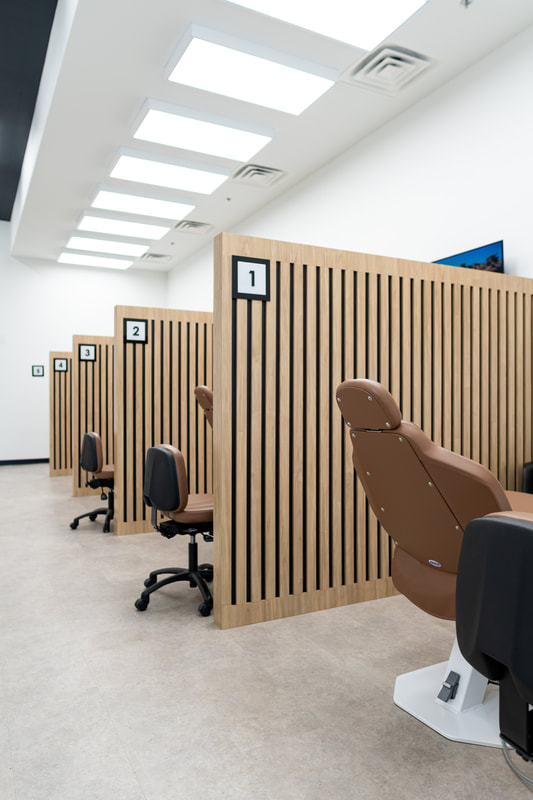|
The design of an orthodontic office is not just about aesthetics; it plays a crucial role in patient comfort, staff efficiency, and overall productivity. In this blog post, we'll explore the key considerations for designing the perfect floor plan for an orthodontic office.
1. Reception Area The reception area is the first point of contact for patients, and it sets the tone for their experience. It should be welcoming and comfortable. Consider these elements: - A spacious and well-lit area with comfortable seating for patients and their companions. - A welcoming front desk with a friendly receptionist to greet patients. - Educational materials and visuals to inform patients about orthodontic treatments. - A designated kids' corner with toys and books to keep young patients entertained. In addition to these elements, it's crucial to size the reception area in a way that matches the anticipated patient volume and the number of treatment chairs in your office. For instance, if you plan to see 80-100 patients a day, ensure the reception area can efficiently accommodate this volume without overcrowding. 2. Treatment Rooms Treatment rooms are the heart of the orthodontic office. They should be designed for efficiency and patient comfort: - Open Bay Treatment Rooms: Traditionally, open bay treatment rooms are designed with multiple chairs in one large space. This layout encourages a communal and social atmosphere and can be more cost-effective. However, post-COVID, some patients may prefer a higher level of privacy. - Open Bay Treatment Rooms with Privacy Walls: In response to changing patient preferences and the need for enhanced privacy in the post-COVID era, many orthodontic offices are adopting open bay treatment rooms with privacy walls. These walls can be either partial or full height and provide a level of separation and privacy for patients. They still allow for a sense of community but offer a compromise between the traditional open bay and fully enclosed treatment rooms. You can look at our privacy walls at Elate Orthodontics by clicking here. When discussing the floor plan for your orthodontic office, consider the patient experience and their comfort level in the treatment rooms. The choice between open bay and open bay with privacy walls should align with your practice's philosophy and the preferences of your patient demographic. 3. Sterilization Area: Optimizing Instrument Workflow The sterilization area in your orthodontic office is a critical component of infection control and patient safety. Ensuring an efficient flow of instruments from the point they are used to when they are ready for reuse is vital. Here's how you can optimize this workflow: Dirty to Clean Instrument Flow: 1. Dirty Instruments In: Begin with a designated area where used instruments are collected. 2. Washing and Cleaning: Once collected, the dirty instruments should be taken to the washing area. Here, they are thoroughly cleaned and prepped for sterilization. Ultrasonic cleaners, and other cleaning equipment should be readily available and properly sequenced. 3. Drying: After cleaning, the instruments should be thoroughly dried to prevent any remaining moisture, which can impact the sterilization process. You should have dedicated drying racks or stations to ensure this step is done correctly. 4. Bagging: Clean, dry instruments should be carefully bagged or packaged in sterilization pouches. These pouches should be clearly labeled with the date of sterilization to ensure proper tracking and adherence to infection control standards. 5. Sterilization: The next step is the actual sterilization of the instruments. This is typically done using autoclaves, our favorite is M-11 Midmark. It's crucial to monitor the autoclave's performance regularly and maintain proper sterilization records. 6. Moving to the Clean Area: Once sterilized, the instruments should be carefully transported to the clean area. This area should be kept separate from the dirty area to prevent cross-contamination. Implement a clear system for organizing and storing sterilized instruments until they are needed. An efficient instrument workflow in your sterilization area not only ensures patient safety but also allows your orthodontic practice to run smoothly. Patients can be confident in the cleanliness and safety of the instruments used in their treatments, and your staff can work more efficiently with well-organized and optimized processes. 4. Consultation Room: Enhancing the Patient Experience and Flow A dedicated consultation room in your orthodontic office is a vital space for discussing treatment plans and making crucial decisions with your patients and their families. To optimize the patient experience and maintain a smooth flow of new patient exams, consider the following: Strategic Placement: - Proximity to Waiting Area: Locate the consultation room close to the reception area and waiting room. This ensures that patients and their families can easily transition from the initial check-in to the consultation, maintaining a smooth flow of new patient exams. - Near the X-ray Room: Placing the consultation room in proximity to the X-ray and imaging room is highly advantageous. This strategic placement allows for quick access to X-ray images and facilitates a seamless transition from diagnostic imaging to consultation. By strategically placing the consultation room, using technology to display X-rays and scans, and creating a comfortable and private space for discussions, you can provide a more comprehensive and patient-centered approach to orthodontic consultations. This not only ensures that patients and their families have a clear understanding of their treatment options but also helps maintain a smooth flow of new patient exams in your orthodontic office. 5. X-ray and Imaging Room: Ensuring Compatibility Orthodontic treatment often relies on diagnostic imaging to make informed decisions and track progress. To ensure that your X-ray and imaging room is well-equipped and properly designed, consider the following: Machine Compatibility: - Know Your X-ray Machine: Before planning the X-ray room, it's essential to have a clear understanding of the specific X-ray machine you are purchasing. Different X-ray machines have varying space and power requirements, and their dimensions can significantly impact the room design. - Room Dimensions: The dimensions of your X-ray machine should align with the dimensions of the X-ray room. Ensure that the room can comfortably accommodate the machine while leaving space for the technician to operate it and for patients to be positioned appropriately. - Lead-Lined Walls: depending on state regulations, X-ray rooms may have lead-lined walls to protect patients, staff, and the surrounding areas from radiation exposure. Confirm that the lead-lined walls are in line with the safety standards for the X-ray machine you plan to use. - Power Requirements: Different X-ray machines have varying power requirements. Ensure that the electrical supply in the X-ray room meets the specifications of your chosen machine. This includes voltage, current, and the need for any additional power outlets. - Technician Workspace: Design the X-ray room to provide ample space for the technician to work comfortably and safely. Adequate space ensures that positioning patients for X-ray scans is efficient and accurate. 6. Staff Area: Balancing Size and Amenities - Appropriate Size: While it's essential to provide a comfortable space for your staff, avoid making the staff room too large. Most staff members often leave the office during lunchtime to eat, so a moderate-sized staff area is often sufficient. - Washer and Dryer Hookup: Consider adding a washer and dryer hookup to the staff area. This can be convenient for staff who may need to launder their uniforms or other items during the workday. - Break room with seating, kitchenette, and storage for personal items. 7. Mechanical room One key consideration for the mechanical room is its placement. Ideally, it should be located as far back as possible within the office space. Placing the mechanical room away from patient treatment and consultation areas is essential to minimize noise disturbance. The hum of suction and compressor systems and the operation of other mechanical equipment should be virtually imperceptible in the clinical and consultation areas, creating a tranquil atmosphere that enhances the patient experience. Careful planning in the placement of the mechanical room ensures that the critical functions it performs do not interfere with the serenity of your orthodontic practice. 8. Accessibility (ADA compliance) Ensure that the office is accessible to all patients, including those with mobility challenges. Install ramps and make sure doorways are wide enough to accommodate wheelchairs and other mobility aids. 9. Aesthetics and Branding The aesthetics of the office should reflect your practice's brand and create a pleasant atmosphere. Consider elements like color schemes, artwork, and decor that align with your orthodontic office's image. 10. Future Growth Plan your floor layout with potential growth in mind. If your practice is likely to expand, leave space for additional treatment rooms, staff, and equipment. Conclusion Designing the ideal floor plan for an orthodontic office is a thoughtful process that combines functionality, aesthetics, and patient comfort. A well-designed office not only enhances the patient experience but also improves staff efficiency and overall productivity. By carefully considering the elements mentioned above and sizing the reception area to match your patient volume, incorporating open bay treatment rooms with privacy walls, optimizing the workflow in the sterilization area, placing the consultation room strategically, ensuring X-ray machine compatibility, and enhancing the overall patient experience, you can create an orthodontic office that stands out in terms of both form and function, ultimately contributing to the success of your practice. Moreover, don't hesitate to reach out to dental contractors or professional design firms like Joe Architect or Kappler Design for expert guidance and assistance in creating the perfect orthodontic office layout. Comments are closed.
|
AuthorDr. Kevin Baharvand Archives
February 2024
Categories |
|
The Most Comprehensive Orthodontic Office Startup Consulting and Support. Our goal is very simple: to help you independently run every aspect of your practice.
Be sure to join our exclusive White Glove Orthodontist - The Cohort Facebook group here:
www.facebook.com/groups/1422176485029479/ |


 RSS Feed
RSS Feed
